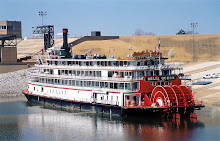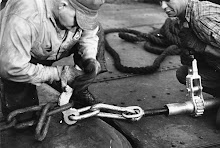
Brownsville Pa. Looking south
A description of the towns and sights along the Monongahela River from Brownsville to Fairmont in the late 1940s, written by the pilot of the towboat COAL QUEEN:
You would never think, to walk the streets of Brownsville today, that the town is old and filled with history and legend. Monongahela Valley towns just do not look the part as do Lexington and Concord and Portsmouth and Gloucester and Boston and Philadelphia. For famous Redstone Old Fort, now Brownsville, is another "industrial town," and aside from the Greek Revival, postColonial Playford House on Second and Market Streets, little romance is visible.
Colonel James Burd selected the site of Redstone Old Fort in 1758 because of the presence there of an early Indian fortification, and built his stockade. In 1785 Thomas and Basil Brown founded the town, which in the years to follow played an important part in the westward movement. It was at Brownsville that the weary emigrants saw the end of their toilsome struggle over the mountains and took to the calm waters of the Monongahela for the next lap of their journey. As the steamboat rose to fame and fortune on the western waters and industrial activity in the valley grew, the Brownsville-Pittsburgh trade developed. Even before the slack-water system had been completed to Brownsville in 1844, there were about two hundred steamboat arrivals annually at Pittsburgh from upriver points. After the locks and dams went into service, there was a daily packet line between Pittsburgh and Brownsville.
There is an old iron bridge in Brownsville that I inspected one time when we were laid up in drydock out at the Hillman shipyard. This bridge is on Market Street near Bank, and it has a tablet on it which says it is the first iron bridge west of the Alleghenies. It was apparently built in the period 1836-1839 of iron forged in Iocal furnaces. Before this bridge was built, Henry Clay's carriage overturned near this spot, dumping the great man into Dunlap's Creek. They say that Clay "gathered himself up with the remark that Clay and mud should not be mixed in that place again." Clay then returned to Washington to his senator's post and shortly afterwards an order was issued for the construction in Brownsville of an "iron span, carrying the road high above the stream."

Maxwell Lock looking south
After we go under the Brownsville Highway Bridge, height 50.2 feet above low water, span 386 feet, we come to Dam 5, and after locking through, we pass the Alicia Marine Ways of the Hillman Company and then are pretty much out in the country, except for coal mines and tipples at regular intervals. There's Vesta tipple and Frick Mine Light, Fox Mine Light and the H. C. F. Coke Company tipple, Vestaburg and Fredericktown and the bend around to Tenmile Creek, and Emerald Tipple, Pumpkin Run, Klein's Sawmill Light, Crucible Fuel Company tipple, and Light, Weirton Steel Company tipple, National Steel Corporation Pier, Buckeye Coal Company tipple, Browns Run, Little Whiteley Creek, Robena Mine Light and tipple, Pittsburgh Steel tipple, Duquesne Light Company tipple, Jacobs Creek, and then around the bend to Dam 7.

Vesta 5 Tipple looking south
Below Dam 7 are Greensboro on the starboard side, and New Geneva on port. New Geneva boasts a population of 410 souls, more or less, and was named for the native city of its famous early settler, Albert Gallatin. Gallatin came to this country without friends or influence, and by the sheer power of his personality and ability (and despite the handicap of a monumental French accent) achieved appointment as a member of the President's Cabinet within ten years of his arrival. A man of many talents, Gallatin served in the Revolutionary War, then became a French instructor at Harvard. Later he journeyed to Richmond on business and there became an intimate of Governor Patrick Henry, who advised him to go west to the wild lands of opportunity out by the Monongahela. Gallatin settled in Fayette County, a few miles from New Geneva and in a short time established the first glassworks west of the Alleghenies. In 1789 he built Friendship Hill, a 2 1/2-story, ivy-covered residence, still standing and open to the public.He began to enter local politics, filling several state and federal posts, and in 1801 was appointed secretary of the treasury by President Jefferson. He served in this post during both of Jefferson's presidential terms, the.whole of President Madison's first term, and until February, 1814, in the second, something of a record in Cabinet tenure. After retirement from the Cabinet this energetic adopted son of the new Republic held several diplomatic posts and finally, between 1831 and 1839 was president of the National Bank of New York.
Patrick Henry said Albert Gallatin was one of the most extraordinary men he had ever seen. He was surely of keen intellectual powers and magnificent ability in political and diplomatic affairs--the model statesman. At Friendship Hill the dignified retirement of Gallatin was embellished in 1825 by a visit from "his long tried, his bosom friend," the Marquis de Lafayeffe. Of this sumptuous affair an old Monongahelite, James Veech (writing in 1858), said: "Who that was there can ever forget the 'feast of reason'--and other good things, and the 'flow of soul'-and champagne? The like of which old Springhill [Township] had never seen--may never see again."
In the five miles upriver from New Geneva to Point Marion, where the Cheat River enters the Monongahela, no less than five coal tipples are busy dumping Pennsylvania coal into waiting barges. Point Marion has a large glassworks and a sand and gravel company which owns a baby Diesel towboat with a steam boiler for operating the steering rig and blowing the whistle, a quaint arrangement unique in my experience.
 Morgantown looking east around 1928
Morgantown looking east around 1928Around a few bends and beyond more tipples, Morgantown rises on the hills to port. Ah, Morgantown, with your glass factories and coal mines and spaghtetti at Capellanti's and houses all peeling from chemical fumes in the air! On Saturday nights in spring the boys and girls from the University of West Virginia, perched up on the hill at the end of Main Street, mingle on the sidewalks down by the courthouse with coal miners and fanners and glassworkers. To us on the Coal Queen, Morgantown was everything, our metropolis--the hot bath, the glass of Tube City beer, the lump-in-throat in the movies, the Girl, paradise, purgatory--we knew them all in Morgantown. But Morgantown knew little of us. Steamboaters, with their excitable and noisy ways, are not invited to tea parties. I can call every bartender and short-order waitress in town by name but the mayor and I have yet to shake hands. Above Morgantown the Monongahela is a beautiful narrow stream running between high hills--"mountains," we always called them. The locks are small, the traffic is light, and there is a friendly intimacy benveen boat crews and lock tenders. The locks are so close that in a six-hour watch you might make seven or eight locks. After a few months of this, running those locks seemed automatic. That's pretty country up in there from Morgantown to National Mine, and pretty again above Jordan, especially in the spring, when the trees and flowers are all in bloom. And then, half blinded sometimes by the smoke from the railroad yard, we come to Fairmont, and beyond it the "Dark Bridge" (no lights on it), which we all hated, and then there was the point, where the Monongahela ended, a point with a big tree on it, a good mark and easy to pick up with the searchlight on a bad night.
The Monongahela is formed by the West Fork River and the Tygart River, which join here at Fairmont, 128.73 miles south of Pittsburgh. The tipple where we loaded coal was at Kingmont, up the Tygart, two miles above head of navigation on the Monongahela, and we would snake our loads out of there in a river so narrow you could nearly jump across.
Now just imagine, in the old days you could take a good big steamboat from Fairmont, West Virginia, at the headwaters of the Monongahela, down to Cairo, up the Mississippi and Missouri to Fort Benton, Mont.--3,623 miles, or about as far as from the North River in New York to the East India Docks on the Thames at London. In fact the stern-wheeler E. H. Durfee made regular trips between Pittsburgh and Fort Benton in the years 1872 to 1876. Wouldn't that be something, to raise steam amidst the roar of industry on the Monongahela and keep that paddle wheel splashing until you began to run into buffalo and Sioux and the Rocky Mountains ?
This is taken from the book The Monongahela by Richard Bissell, part of the Rivers of America series, Rinehart & Co., Inc., New York, 1952, pp. 70-83. He wrote several outstanding books on towboating and the river life. The accounts are gritty and very realistic. He also wrote several successful Broadway plays including The Pajama Game.































